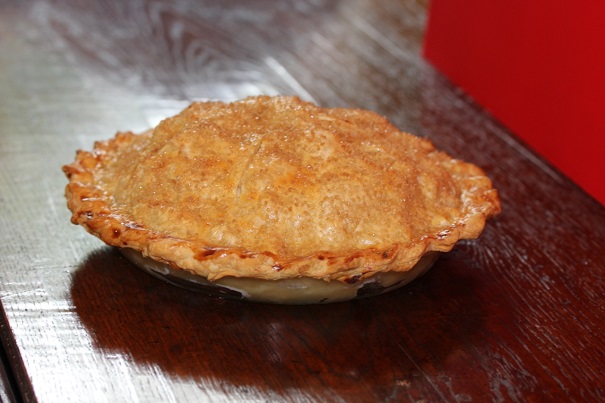Thanks to all of you who sent in questions to America’s Table this month – there were hundreds! Many of the questions were about apples, and I’d like to try to briefly answer as many of those as I can.

- The best apples for baking are those that don’t disintegrate during cooking, and that have a balance of sweetness and tartness. My favorite eating apple is a McIntosh, with its white interior and shiny red-and-green peel, but it is not a good baking apple because it’s too soft. Granny Smiths, Honeycrisps, and Crispins are all good baking apples, but there are lots of other good baking apples to choose from. If you’re making caramel apples, you need a firm, tart apple, like a Granny Smith. Applesauce can be made from virtually any type of apple, though if you want it to be very smooth, like a puree, a McIntosh or Rome apple is a good choice.
- Since apples are grown in many parts of the country, I think the best apples are those that are grown near you, because they will be the freshest. I write a lot about New York apples, but Washington apples are amazing if you live on the west coast. There are wonderful apples just over the DC line in Maryland and Virginia, and you can find many different varieties wherever you live. This is the time of year to really enjoy apples, because after they’ve been in cold storage for a couple of months they lose that snap of flavor that makes them so beloved. They’ll still be good for cooking, but less so for eating.
- When baking apples in a strudel or a pie, one of the most common difficulties is that the apples give off so much liquid as they cook that they dampen the dough and turn it to mush. The way to avoid this is to partially precook the apples first, drain them, and then put them into the pie or strudel. It keeps the bottom dough crisp, and makes it easier to serve.
- Some favorites: I love Granny Smith apples with peanut butter, Braeburns, Cortlands and McIntoshes for apple butter, and Empires and Galas for an apple crisp, but none of this is written in stone. If you mix a little butter, lemon, and cinnamon with apples, whatever you bake is likely to be good. And if you’re cutting up apples for school lunches, a few drops of lemon juice will keep them from turning brown so quickly.
- It’s best to store apples out on a counter or in a paper bag – not in the refrigerator, where the cold will change their chemistry, and also their flavor. If you can’t afford organic apples, the next best thing to do is to peel them before eating, as toxins tend to be found in the peel. Unfortunately, there are also a lot of nutrients in the peel, so it’s not a perfect solution.
- I’m getting lots of questions about how to buy my “product.” I don’t have an apple orchard and I’m not selling anything. I just like to share some of the things I’ve learned about cooking and manners and entertaining. But all these requests are certainly flattering! I’d like to write a cookbook someday, and maybe then I’ll have a product.
- If I did sell food products, I would want them to be organic and non-GMO. Yes, it’s more expensive, and yes there is government oversight of “allowable” amounts of toxins in our food – but what happens when we ingest all of those individual “allowable” amounts of toxins from different foods, and they build up in our bodies? Food security and food safety are issues that have been largely ignored in this country, and it is an important part of our most fundamental right: life. When the founding fathers wrote about life, liberty, and the pursuit of happiness, I don’t think they envisioned obese Americans weakened by poor nutrition, empty calories, and processed foods.
- Several people asked why I write this blog. I think people need to be reminded to be kind to each other. That sounds pretty preachy, but if you put it in the context of manners or etiquette, the specific rules seem to be more acceptable to some people than the reasons behind them. I’ll take the kinder, gentler any way I can get it.
- Secondly, we are learning so much now about how what we eat affects the quality and length of our lives. This knowledge requires most of us to change the eating habits of a lifetime. It can’t be done overnight. Some of my recipes are not healthy, but lots of them are. I’m trying to make the transition to healthier eating too, and if I can bring anyone along with me, so much the better.
- Finally, I think we hear a lot about how much is wrong with America. There’s no denying that we have our work cut out for us these days. But there are a lot of things that are right about America, and I don’t think self-loathing is a useful emotion. America is still a cup of light, and I don’t forget that. I hope this silly blog occasionally reminds people that we’ve got something pretty good going here.
- The easiest way to show off your pretty mixed place settings is to do a pre-set first course. If you use your dessert plate as a salad plate, you can have your guests’ salads (or other first course) already on the table and ready to eat, so they can admire your combination of settings. If you want to use those same plates for your dessert course you have two choices: you can buy more of the patterned plates, or you can use a different set of dishes for your dessert. If you like mixing china patterns, you already know how creative it can be to use several different kinds of china at one meal. As long as you like it, that’s all that matters.
- If you want to cook apples without using sugar, I would recommend using stevia as a sugar substitute. Unlike other sugar substitutes (some of which may not be as healthy as the manufacturers would like you to believe, it can be used in cooking as well as for sweetening tea of coffee. I use it to make applesauce and it doesn’t affect the flavor of the apples.
- Salad can be served both before or after a main course. At formal dinners at the White House, we often served a salad after the main course, often with cheese or dried fruit and crackers or bread. (If we were serving a salad after the main course, the first course would never also be a salad.) This only makes sense if you’re serving a four-course meal. I wouldn’t serve the salad after the entrée if you aren’t serving a first course.




2 Comments